Now is Not the Time for a FONOP in the Arctic
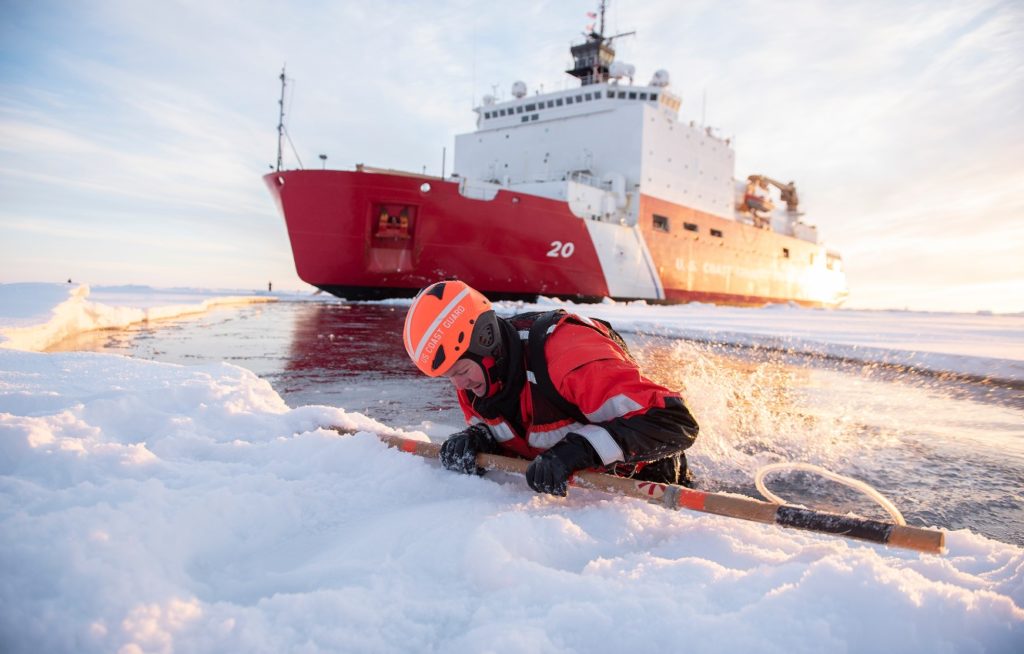
Russia and the United States have started a game of chicken in the Arctic that could lead to an unnecessary military conflict. The Russians have asserted unilateral control over the Northern Sea Route, an international waterway running along Russia’s northern coast, and are deploying military assets at chokepoints along the route.
U.S. officials dispute Russia’s claim to the Northern Sea Route and have threatened to send U.S. naval vessels in a Freedom of Navigation Operation (FONOP). U.S. Secretary of the Navy Richard Spencer has spoken of “having some ships make the transit in the Arctic. Freedom of navigation should be applied up there.” These sentiments were echoed by General Curtis Scaparrotti, former supreme allied commander in Europe, in congressional testimony, suggesting that an Arctic FONOP would be aimed at Russia. In May, Secretary of State Mike Pompeo warned, “We’re concerned about Russia’s claim over the international waters of the Northern Sea Route.” The Department of Defense’s unclassified June 2019 Arctic Strategy stated that U.S. interests in the Arctic included “ensuring freedom of navigation and overflight” and called out Russia as a threat in the Arctic.
Conducting an Arctic FONOP is a bad idea. In the short run, it is likely to result in disaster given inadequate U.S. icebreaking capabilities. It could also trigger a military confrontation given Russian vital interests in the region and their military advantages along the route. Even if the United States could redress those imbalances in the medium-term, it should still resist the FONOP idea. Successfully traversing the Northern Sea Route could lead to even more assertive Russian behavior, will not make shipping companies any more likely to resist Russian demands, and will damage U.S-Canadian relations by setting a dangerous precedent for the contested Northwest Passage. Instead of a short-term FONOP, the United States should promote a longer-term counter-narrative that emphasizes innocent passage in Arctic waters, watches for (and exploits) divergent Sino-Russian Arctic priorities, and builds the capabilities necessary to manage Alaskan waters and support NATO allies in the Arctic.
The Importance of the Northern Sea Route
The Arctic’s climate has not been this hot in 10,000 years and is warming at an alarming pace, raising the possibility of viable Arctic shipping routes. The Northern Sea Route, one of three main passages through Arctic waters, runs along Russia’s northern coast from Murmansk in the west to the Bering Strait in the east. It is usually the first, and sometimes the only, polar shipping route each summer and the last to become ice-encumbered each fall. The route makes travel between Europe and Asia roughly 3,000 miles shorter and 11 days quicker than a southern transit via the Strait of Malacca and Suez Canal.
Core Russian economic and security interests — and aspects of national identity — are at stake in and around the Northern Sea Route. Economically, one-fifth of Russia’s Gross Domestic Product (GDP) and over 30 percent of government revenue comes from the Arctic, according to some estimates. Much of that is from the Yamal Peninsula’s oil and natural gas fields. Russia also has the potential to raise funds from Northern Sea Route user fees and tolls. In terms of security, the Russian Arctic is home to much of Russia’s strategic nuclear deterrent in the form of its Northern Fleet submarines based outside of Murmansk. Were the United States to attack those submarines, it would most likely route that attack over the North Pole and across the the route along Russia’s border. One way for Russia to protect their nuclear deterrent, then, is to limit access to and across the Northern Sea Route. Finally, the Arctic resonates with Russians’ conceptions of self and with the Putin regime’s desire to maintain great power status. As detailed below, these interests have led Russia to become more assertive in its control of this route.
There are five choke points along the Northern Sea Route where Russia could conceivably delay or stop shipping traffic should it so choose. These are places where the channel flows between two pieces of Russian territory, if not within their 12-mile territorial waters. Passing through one or more of these choke points, circled in Figure 1, is inevitable for users of the route The United States rejects Russian control and militarization of the Northern Sea Route and seemingly wants to conduct a FONOP to demonstrate that rejection.
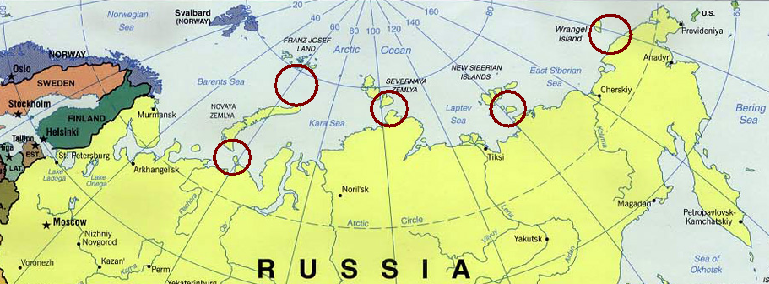
Figure 1: Northern Sea Route Chokepoints (CIA World Factbook)
Risks to a U.S. FONOP
The United States has a big problem if it wants to conduct an Arctic FONOP — it doesn’t have the right ships to do it. The Navy has no ice-capable warships in its inventory, though it is studying the issue. Though the Coast Guard has one heavy and one medium icebreaker, neither is available for a FONOP in this region. The heavy icebreaker, the Polar Star, is dedicated to resupplying Antarctic research stations for roughly seven months a year. It is in dry-dock for repairs and refitting during the Northern Hemisphere’s summer, exactly the time when the United States would conduct a FONOP. The medium icebreaker, the Healy, is used along the Alaska coast during navigable summer months for search and rescue and to support Arctic scientific missions.
Most importantly, both ships are old and could break down during a FONOP. In that event, the United States would have to ask Russia for emergency assistance. Alternatively, Washington could partner with a country that had spare summer icebreaking capacity — like Finland or Sweden — but would have to convince that partner that the benefits of challenging Russian policy would outweigh the likely Russian blowback aimed at them. That capability deficit would leave a U.S. FONOP vulnerable to the highly changeable and potentially severe Arctic environment.
Compounding the U.S. ends-means mismatch are Russian military capabilities along the Northern Sea Route. The Russians now require passage users to request permissions, accept ice-pilots, and provide payoffs before traveling. Should transiting vessels violate any of these stipulations they are subject to being boarded, inspected, fined, impounded, and even destroyed.
The Russians say they are well within their rights to regulate the Northern Sea Route given Articles 21 and 234 of the UN Convention on the Law of the Sea (UNCLOS). Article 21 gives states the ability to regulate their territorial waters. Russia claims that parts of the route are within their territorial waters. Article 234 states that countries with adjacent ice-covered waters can regulate those waters if doing so will protect the environment. The only restraint on that power is the “due regard” for navigation, a vague statement that leaves much to interpretation. Russian Foreign Minister Sergei Lavrov recently noted, “We will do everything to ensure that the movement of foreign ships is in full compliance with the 1982 Convention on the Law of the Sea, that it is carried out in full compliance with all international legal norms, and that it is absolutely safe.”
Russian military capabilities could threaten or sink U.S. ships attempting a FONOP. The Russians are deploying anti-ship systems at choke points along the passage to deter unauthorized users, essentially extending their anti-access/area denial capabilities east from the Barents Sea where Russia has long implemented a Bastion defense doctrine to protect its submarine-based nuclear deterrent. Russia does not have to destroy violating ships to control Northern Sea Route access, but having the ability to harm violators makes possible the threat to board or impound vessels. Possible sea-based targets include large ships that carry bulk cargo, liquid natural gas tankers, container ships, and icebreaker escort vessels. The Swedish Defense Research Agency has recently produced an open-source, technical assessment of Russian A2AD military systems. Figure 2 displays the threat to shipping from the Russian Bastion and Bal anti-ship systems at three of the five Northern Sea Route chokepoints using ranges from the Swedish report, places where open-source reporting locates these or similar systems.
Barents-Kara Seas (western Northern Sea Route)
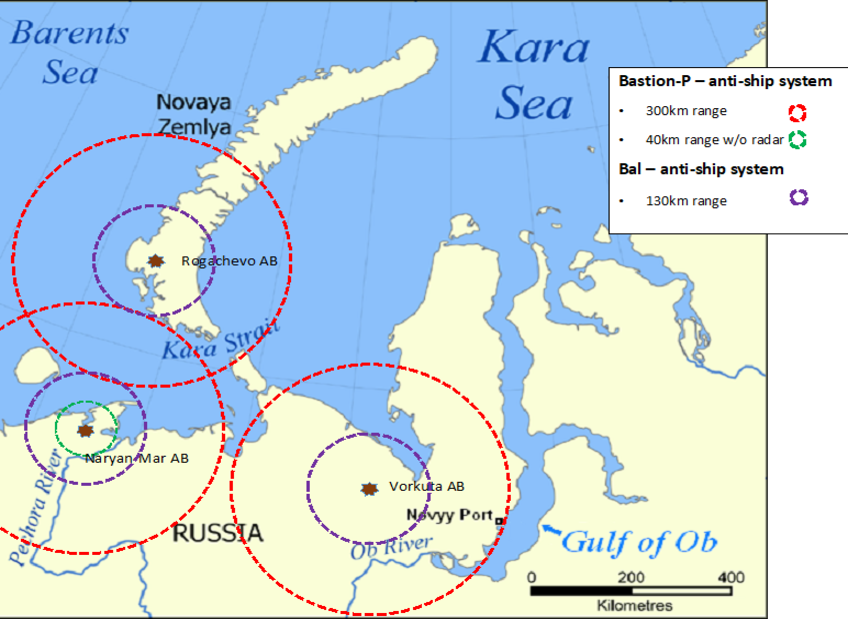
Kotelny (mid-way through Northern Sea Route)
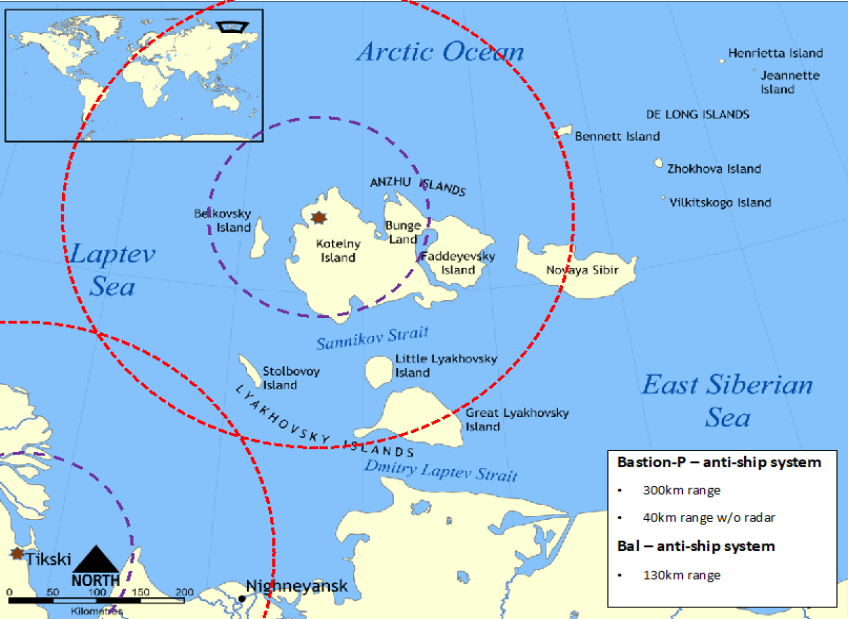
Wrangel Island (eastern Northern Sea Route)
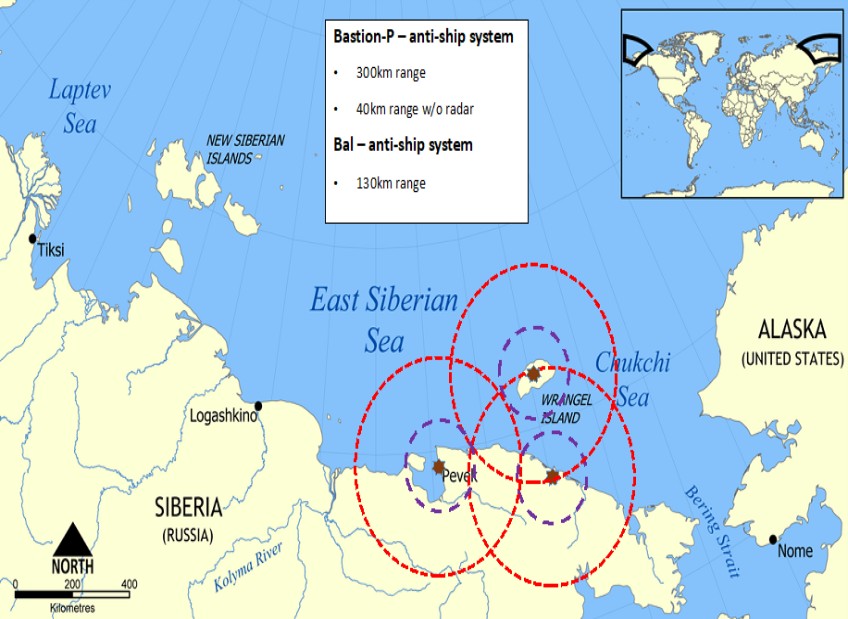
Figures 2-4: Anti-Ship Ranges at Northern Sea Route Chokepoints (Map by Norman Epstein. Threat rings by David Auerswald)
Russia can also threaten aircraft that might protect or attempt to rescue seized or attacked ships and crew. Airframes that could conduct rescue operations include transport, rotary, or refueling aircraft, all relatively large and slow-moving targets. Figure 3 displays the threat rings for the S-400 (SA-21 Growler) air-defense system at the same three chokepoints using FOI-derived ranges. The S-400 system armed with the 48N6 and 9M96 interceptors provides a wide defensive circle against rescue aircraft trying to liberate an impounded ship and could make attacks against the Bastion or Bal anti-ship systems difficult. And note that Russian doctrine calls for the deployment of air defense systems rather than single capabilities. That means that the S-400s themselves could be protected from attack by shorter range air defense systems like the Pantsir (SA-22 Greyhound).
Barents-Kara Seas (western Northern Sea Route)
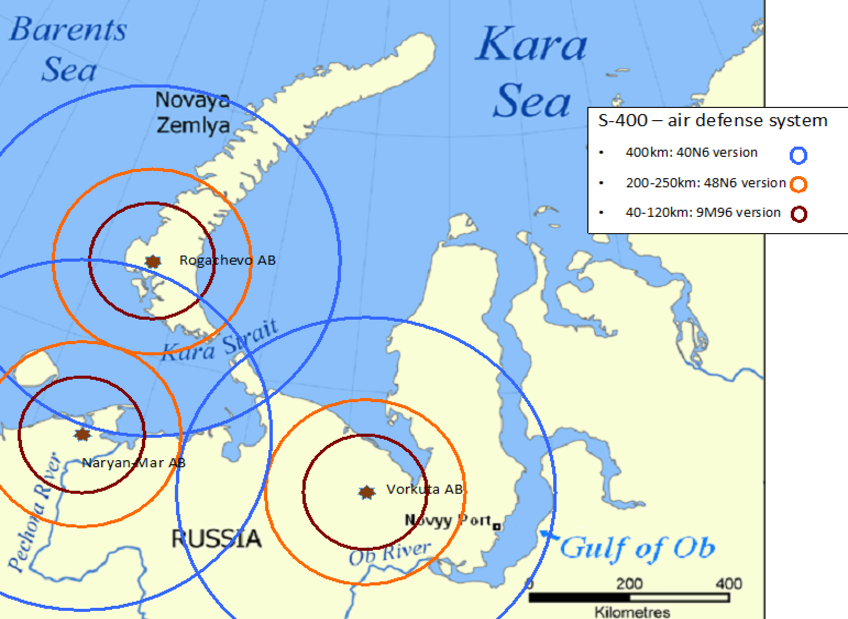
Kotelny (mid-way through Northern Sea Route)
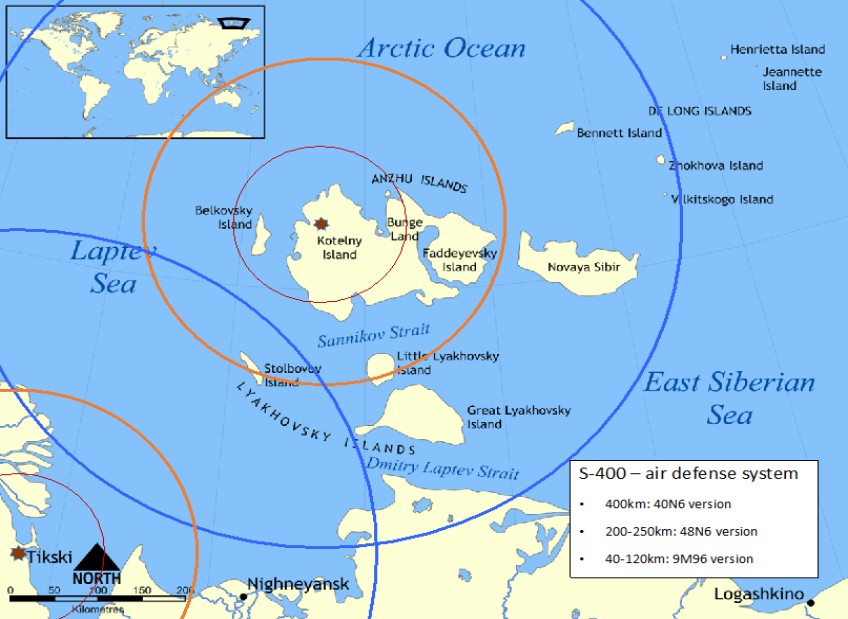
Wrangel Island (eastern Northern Sea Route)
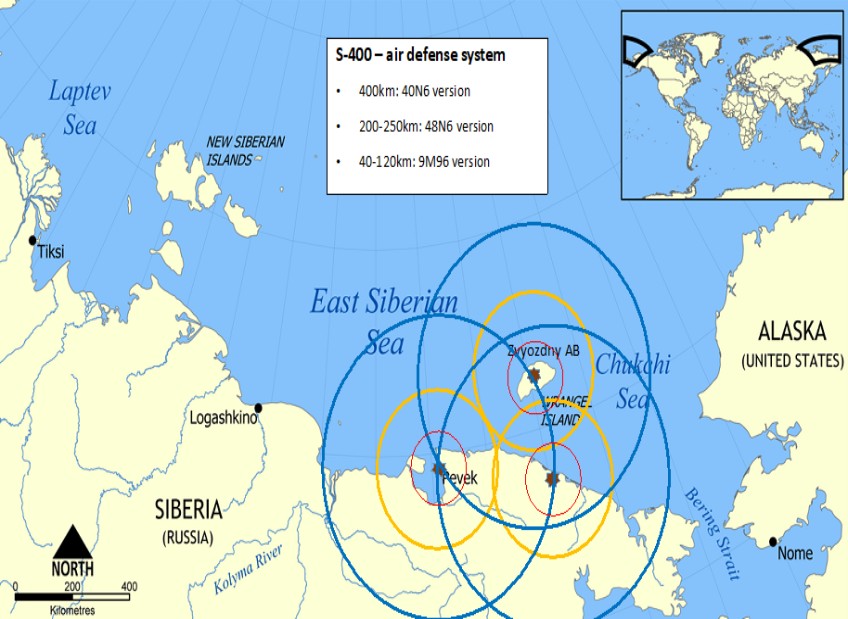
Figures 5-7: Anti-Air Ranges at Northern Sea Route Chokepoints (Map by Norman Epstein. Threat rings by David Auerswald)
The Russians have started to overtly deploy these systems at chokepoints, according to open source reports. Air defense systems are being installed that “will fully cover the Arctic air space as a shield,” according to Admiral Nikolay Yevmenov, Russia’s Northern Fleet Commander. Lavrov has said that Arctic bases will “ensure the necessary defense capability in view of the military-political situation near our borders.” Russia has also conducted weapons tests in the Barents and Kara seas.
In short, the lack of U.S. capabilities leaves U.S. vessels vulnerable to changing sea ice conditions. The relative imbalance between American and Russian capabilities makes a FONOP militarily dangerous.
Risks from a U.S. FONOP
Even if the United States were to redress the capabilities imbalance, an Arctic FONOP is still a bad idea because of the risks from such an action. The long-run implications are dire should a FONOP fail, even if it did not lead to a military confrontation. Failure would build perceptions that the United States can’t compete in the Arctic and that Russia can get away with violating freedom of navigation when challenged. Such failure could have ripple effects for NATO’s posture in the High North, and for future Russian behavior. The Chinese, who are attempting inroads in the Arctic, could become emboldened.
There are potentially bad secondary consequences even if a U.S. FONOP succeeds. Russia has core interests at stake along the Northern Sea Route. The United States does not. Russia could reimpose Northern Sea Route restrictions immediately after a U.S. FONOP or deploy more extensive Russian capabilities, making future FONOPs more difficult. Remember that Russian behavior in Crimea, eastern Ukraine, and online (with regard to election interference) continued even in the face of Western sanctions. If Russian behavior did not change in response to strong sanctions, there is little reason to think that it will change after a few U.S. ships sail through the Northern Sea Route.
U.S. officials also should understand that none of this will be done in isolation. A successful FONOP has implications for the American and Canadian dispute over the Northwest Passage, which Canada claims is an internal waterway and a core Canadian interest. The Canadians would have to wonder if the Americans would feel bound to actively contest Canada’s claim, rather than quietly agreeing to disagree as has been the case since the 1980s. A Northwest Passage dispute would further strain cross-border relations, with implications for bilateral political, trade, and security cooperation.
Finally, shipping companies may continue to comply with Russian demands even if a FONOP succeeds because the United States cannot maintain a permanent presence in the Northern Sea Route. Shipping companies are loath to travel routes unless indemnified from loss, and insurance companies hate risk. Yes, Russian tolls will inflate shipping costs. Yet shipping companies will be under significant pressure from insurance companies to pay a known toll rather than risk the much larger potential cost of losing a vessel (either to ice, weather, or the Russians). As a result, shippers will comply with Russian demands if they want insurance because the costs of user compliance are lower than the potential costs of noncompliance.
What Should be Done
Instead of threatening to conduct Arctic FONOPs that are unlikely to advance U.S. interests, the United States should play the long game. First, the United States should publicly reject Russia’s assertions of unilateral control, an action that would be consistent with long-standing U.S. practice regarding international waterways. The United States should launch a counter-narrative focused on United National Convention on the Law of the Sea Article 19, which provides for innocent passage in territorial waters, and argue that Article 234 should only be relevant in the winter, when ice covers the Northern Sea Route, rather than apply year-round. At the same time, the United States should continue with FONOPs where it has more robust capabilities, such as in the South China Sea or Persian Gulf, to maintain U.S. leverage on the larger point of innocent passage in international waterways. U.S. credibility does not require a FONOP in every contested waterway, just in enough instances to demonstrate the will to uphold international principles.
Second, western nations should carefully monitor Sino-Russian dialogue over Northern Sea Route access. To this point China has not invested in Northern Sea Route infrastructure like they have in Yamal LNG (whether because of poor expected returns on investment or because of Russian policy is unclear). China, with two heavy icebreakers and a third under construction, has the potential to eventually challenge Russian control of the NSR and has significant interest in importing Arctic raw materials. The United States should watch for an indicator from China, such as if the country secures a regular supply of raw materials from the European Arctic, particularly rare earth minerals from Greenland or fish stocks from the North Atlantic, Greenland, or Norwegian Seas. If so, China might see the Northern Sea Route in a new light.
Third, U.S. officials need to acknowledge, if only privately, that there is no urgent need to conduct a FONOP in the region. Russian control of the Northern Sea Route will have minimal effects on shipping. Statistics suggest that most voyages on this route are destinational rather than truly international. Ships are supporting Yamal LNG projects and other Russian infrastructure development. Few voyages are traversing the full Northern Sea Route between Europe and the Pacific. In the long-run, control of the sea route could be a moot point from a shipping perspective if a transpolar route becomes viable in 20-30 years.
Finally, the United States needs to rethink Arctic maritime operations writ large. It should build icebreakers and ice-capable surface ships, not for Arctic FONOPs but to support search and rescue operations in and maritime control of Alaskan waters. Those capabilities could also address American defense responsibilities toward NATO allies Canada, Denmark, Iceland, and Norway. Until then, the United States should be very, very cautious about saber-rattling in the Russian Arctic, and do so only after thinking through the long-term implications of failure and success.
Disclaimer: The views in this article are those of the author and not the National War College, the Department of Defense, or any other U.S. government entity.
Dr. David Auerswald is a Professor of Security Studies at the U.S. National War College in Washington, D.C. He has published books on ISAF operations, congress and national security, congress and civil-military relations, the politics of coercive diplomacy, and the Kosovo conflict.
Image: U.S. Coast Guard (Photo by Senior Chief Petty Officer NyxoLyno Cangemi)

